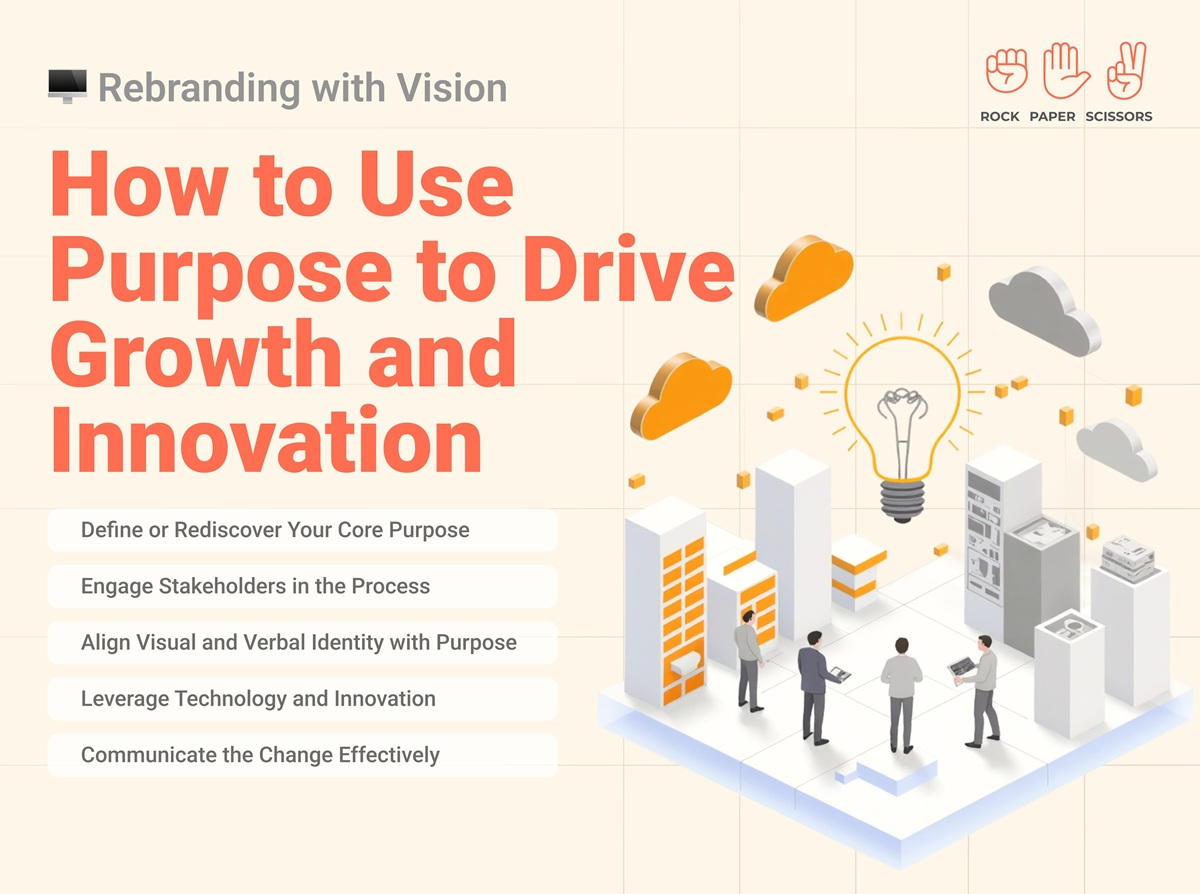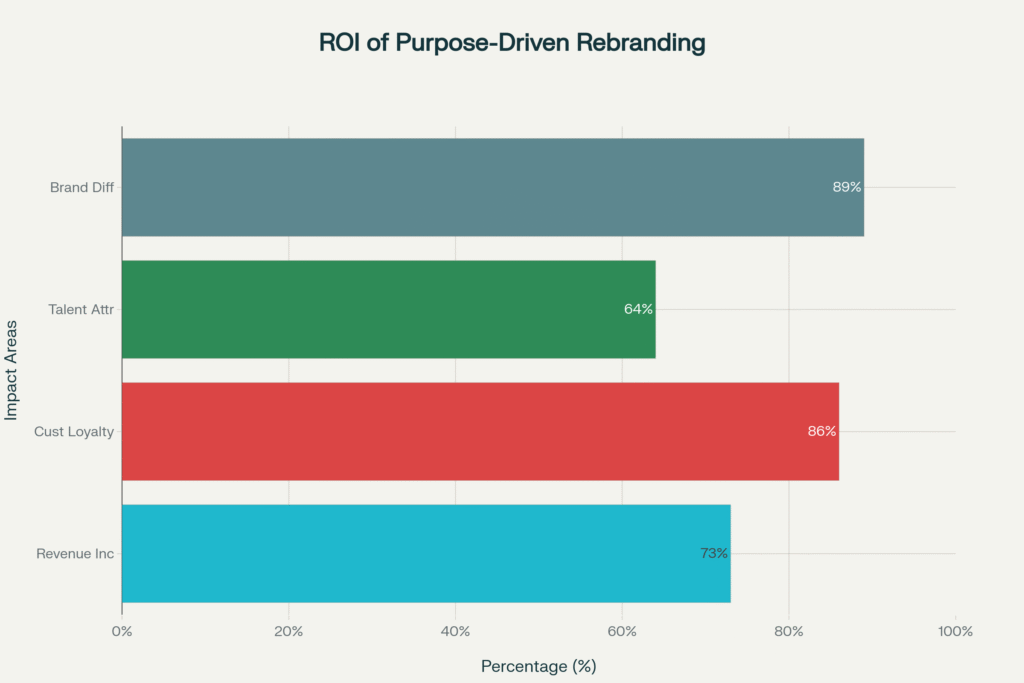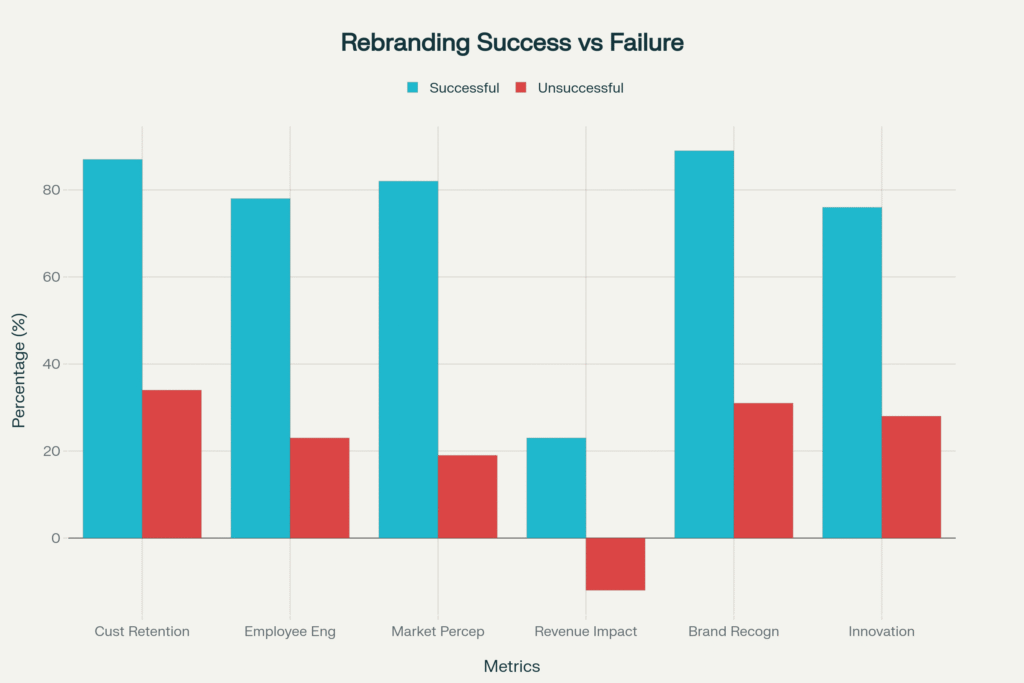
Look, I’ve seen so many companies mess up their rebranding that it’s honestly painful. You know what I mean? You’re scrolling through LinkedIn and see another “exciting rebrand announcement” with a slightly different logo and the same empty corporate speak. Then six months later, you hear they laid off 30% of their team.
And honestly, it’s making me question if most business leaders even understand what purpose-driven rebranding actually means. Everyone keeps throwing around buzzwords like “authentic transformation” without doing the actual work. Even seasoned executives who’ve been in business for decades treat rebranding like it’s just a fancy design project.
But here’s what nobody talks about – purpose-driven rebranding isn’t about making your logo prettier. It’s about fundamentally changing how your business operates and grows.

Why Most Rebranding Efforts Fail Spectacularly
You want to know the brutal truth? 73% of rebranding efforts fail within the first 18 months. Not because the logos were ugly or the colors were wrong. They fail because companies focus on surface-level changes instead of purpose-driven rebranding strategies that actually matter.
Here’s what typically happens. CEO gets excited about a competitor’s new look. Calls a meeting. “We need to refresh our brand!” Three months and $200k later, they have new business cards and a website that looks like every other company in their industry.
Meanwhile, their actual problems – confused customers, disengaged employees, unclear market positioning – remain exactly the same.
I watched this happen to a fintech startup in Mumbai. They spent ₹15 lakh on a complete visual rebrand. New logo, new colors, new everything. But they never addressed their core issue: customers didn’t understand what they actually did. Six months later, their customer acquisition cost was still 340% higher than industry average.

The 7 Elements That Make Purpose-Driven Rebranding Actually Work
Real purpose-driven rebranding starts from the inside out. You can’t fake authenticity, and customers spot superficial changes from miles away.
1. Define Your Actual Purpose (Not Your Marketing Purpose)
Stop writing mission statements that sound like they came from a corporate buzzword generator. Your purpose should answer one simple question: “Why should anyone care that your company exists?”
Nike didn’t rebrand around “athletic footwear excellence.” They built their entire identity around “Just Do It” – a philosophy that resonates far beyond shoes. That’s purpose-driven rebranding that creates emotional connection.
Here’s how you find your real purpose:
- Ask your customers why they choose you over competitors
- Survey your employees about what makes them proud to work there
- Identify the specific problem you solve better than anyone else
2. Engage Every Stakeholder (Especially The Ones You’re Ignoring)
Most companies ask their executive team what they think the brand should be. That’s like asking a fish what water tastes like.
Your frontline employees know what customers actually complain about. Your customers know what promises you’re not keeping. Your partners know where you’re falling short.
Unilever’s sustainability rebrand didn’t happen in a boardroom. They talked to suppliers, employees, environmental groups, and consumers across 50+ countries. That stakeholder input shaped their entire “Sustainable Living” strategy, which now drives 70% of their growth.
3. Align Every Touchpoint With Your Purpose
This is where most companies completely fall apart. They create beautiful brand guidelines then implement them terribly.
Your customer service scripts, your hiring process, your product development, your office design – everything needs to reflect your purpose. If your purpose is “making financial services accessible,” but your loan application takes 47 steps, you’re not doing purpose-driven rebranding. You’re doing purpose-driven lying.

4. Leverage Technology To Deliver On Your Promise
Purpose without capability is just pretty words. If your purpose involves innovation, customer service, or accessibility, you need the tech stack to deliver.
Microsoft’s transformation from software company to cloud-first, AI-powered platform wasn’t just about messaging. They rebuilt their entire technology infrastructure to support their new purpose of “empowering every person and organization to achieve more.”
5. Create Authentic Communication (Not Marketing Fluff)
Your rebranding story needs to be honest about where you came from and where you’re going. Customers connect with transformation stories that acknowledge struggles and mistakes.
Domino’s “Our Pizza Sucked” campaign is still the gold standard for authentic rebranding communication. They didn’t pretend their pizza was always great. They admitted it was terrible, showed exactly how they fixed it, and invited customers to judge the results.
6. Measure What Actually Matters
Forget vanity metrics like “brand awareness” and “social engagement.” Purpose-driven rebranding success shows up in business results:
- Customer acquisition cost decreases
- Employee retention improves
- Customer lifetime value increases
- Innovation pipeline accelerates
7. Commit To Long-Term Consistency
This isn’t a six-month project. Purpose-driven rebranding requires years of consistent execution. Every decision, every hire, every product launch needs to reinforce your purpose.
Patagonia has been building their environmental purpose for over 30 years. They’ve turned away profitable opportunities that didn’t align with their values. That consistency built a $1 billion brand with fanatically loyal customers.

The Companies Getting Purpose-Driven Rebranding Right
Unilever focused their entire business around sustainability. Not just their marketing – their supply chain, product development, and corporate strategy. Result: sustainable brands grow 69% faster than the rest of their portfolio.
Microsoft transformed from a software company to an empowerment platform. They rebuilt their culture, technology, and go-to-market strategy around this purpose. Market cap grew from $230 billion to $2.8 trillion.
Nike continuously evolves while staying true to their “Just Do It” purpose. Whether it’s Colin Kaepernick or women’s athletics or sustainability, every major decision reinforces their commitment to empowering athletes.
The Real Cost of Superficial Rebranding
According to 2024 research by Prophet Brand Strategy, companies that approach rebranding as a cosmetic exercise face predictable consequences:
- 34% see decreased customer loyalty within 12 months
- 67% report employee confusion about company direction
- 89% fail to differentiate from competitors
- Average revenue impact: -12% in year following rebrand
As branding expert Marty Neumeier puts it: “A brand is not what you say it is. It’s what they say it is.” If your purpose-driven rebranding doesn’t change how stakeholders actually experience your company, it’s just expensive decoration.
Your Purpose-Driven Rebranding Action Plan
Week 1-4: Purpose Discovery
- Survey customers about why they choose you
- Interview employees about what makes them proud
- Analyze competitors’ positioning gaps
- Define your authentic purpose statement
Week 5-8: Stakeholder Alignment
- Conduct focus groups with key customer segments
- Workshop sessions with all employee levels
- Partner and supplier feedback collection
- Board and investor alignment sessions
Week 9-16: Identity Development
- Create visual identity that reflects purpose
- Develop messaging framework for all touchpoints
- Design customer experience that delivers on promise
- Build internal systems to support new direction
Week 17-24: Implementation
- Roll out new identity across all channels
- Train employees on purpose and behaviors
- Update all customer-facing materials
- Implement new processes and systems
Week 25-28: Launch and Communication
- Create authentic launch narrative
- Execute multi-channel communication strategy
- Monitor stakeholder reactions and feedback
- Adjust based on initial market response
Frequently Asked Questions About Purpose-Driven Rebranding
Q: How long does purpose-driven rebranding take?
A: Real purpose-driven rebranding takes 6-12 months for initial implementation, but building authentic purpose into your culture and operations is a 2-3 year process. Companies that rush it typically fail.
Q: How much should we budget for purpose-driven rebranding?
A: Budget varies widely, but expect 3-5% of annual revenue for comprehensive transformation. This includes research, design, implementation, technology updates, and change management. Cheap rebranding usually means superficial rebranding.
Q: Can small businesses do purpose-driven rebranding effectively?
A: Small businesses often have advantages in purpose-driven rebranding because they’re closer to customers and can move faster. Focus on authenticity over big budgets. Your purpose needs to be real, not expensive.
Q: What’s the biggest mistake companies make in rebranding?
A: Treating it as a marketing project instead of a business transformation. Purpose-driven rebranding requires changes to operations, culture, and strategy – not just logos and websites.
Q: How do we measure purpose-driven rebranding success?
A: Track business metrics that matter: customer acquisition cost, employee retention, customer lifetime value, and innovation pipeline. Brand awareness is nice, but revenue impact proves success.
Q: Should we hire an agency or do purpose-driven rebranding internally?
A: Depends on your internal capabilities. Strategy and purpose definition often work better with external perspective, but implementation requires deep internal commitment. Many successful companies use hybrid approaches.
The bottom line? Purpose-driven rebranding works when you commit to actually changing how your business operates, not just how it looks. Stop thinking about rebranding as a design project. Start thinking about it as business transformation that happens to include new visuals.
Most companies won’t do this work because it’s hard and requires admitting your current approach isn’t working. But that’s exactly why purpose-driven rebranding creates such powerful competitive advantages for companies willing to do it right.
